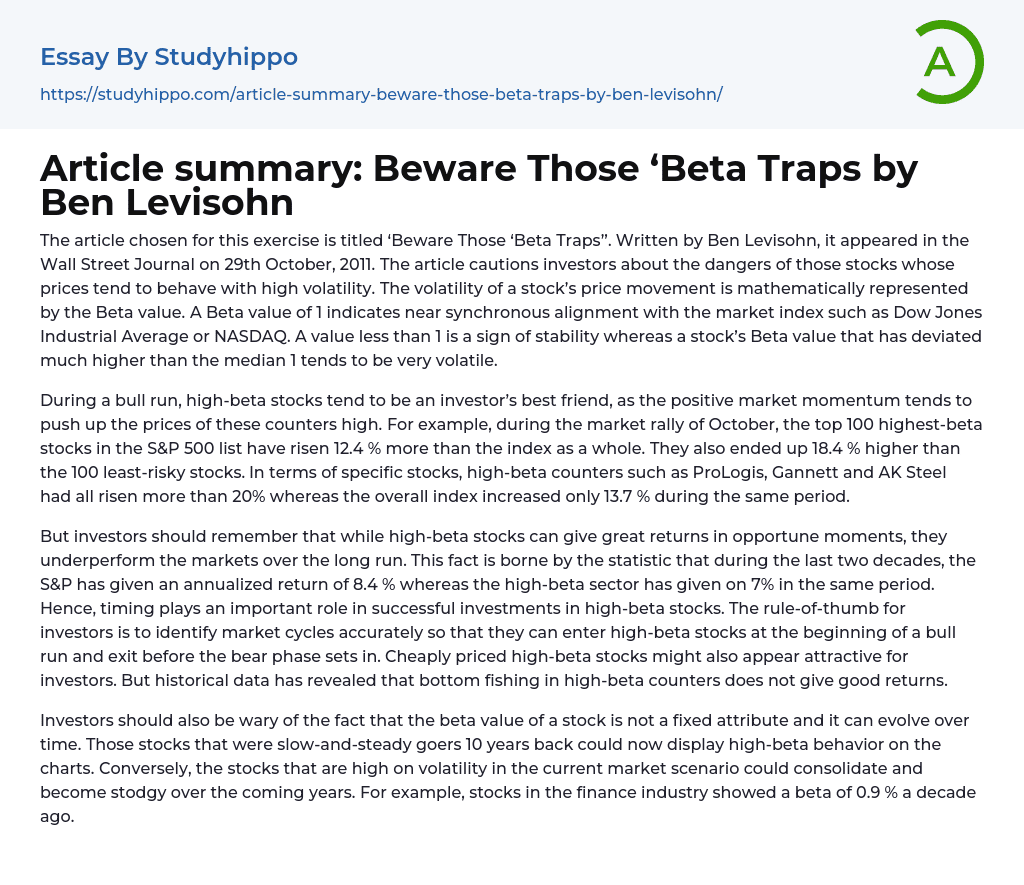

Article summary: Beware Those ‘Beta Traps by Ben Levisohn Essay Example
The selected article, titled 'Beware Those 'Beta Traps'' by Ben Levisohn, was published in the Wall Street Journal on October 29, 2011. It discusses the risks associated with stocks that exhibit high price volatility. The volatility of a stock's price movement is quantified by its Beta value. A Beta value of 1 indicates a strong correlation with market indices like the Dow Jones Industrial Average or NASDAQ. A value below 1 suggests stability, while a significantly higher Beta value signifies high volatility for a stock.
During a bull run, high-beta stocks tend to experience significant price increases, making them desirable for investors. For instance, in October's market rally, the top 100 highest-beta stocks in the S&P 500 outperformed the index by a 12.4% increase. Additionally, these high-beta stocks surpassed the 100 least-risky stocks by an 18.4% gain. Notab
...ly, specific high-beta stocks like ProLogis, Gannett, and AK Steel rose over 20%, while the overall index only grew by 13.7% during that period.
Although high-beta stocks may offer attractive returns at times, it is important for investors to realize that they typically underperform the market over a long period of time. This can be seen when comparing the average annual return of 8.4% for the S&P over the past two decades to the 7% return achieved by the high-beta sector during that same timeframe. Therefore, successful investments in high-beta stocks rely heavily on timing. It is advisable for investors to accurately identify market cycles and enter high-beta stocks at the start of a bull market while exiting before a bear market begins.
Investors may also have an interest in low-priced high-beta stocks. However, historical data indicates that seeking bargains withi
this category does not result in favorable returns.
Investors should be cautious as a stock's beta value is not constant and can change over time. Previously stable stocks may now have high-beta behavior, while currently volatile stocks may become less volatile in the future. For instance, a decade ago, finance industry stocks had a beta of 0.9%, which has now increased to 1.6. Similarly, utility stocks had a low beta of 0.12 ten years ago but have since risen to 0.46. Additionally, there has been an increase in the number of high-beta small cap consumer-discretionary and energy stocks over the past five years.
Investors should be cautious when selecting stocks with a high-beta track record, as it involves risk. It is important to thoroughly research stocks before investing to ensure reasonable future earnings. Good stocks often come at a higher price, but prudent investors should be willing to pay the "scarcity premium". It is also beneficial for intelligent investors to recognize the differences in characteristics among stocks from various industries. For instance, the materials sector is more likely to outperform the financial sector in the markets.
Work Cited:
Ben Levisohn warns about the dangers of falling into "beta traps" in his article published on online.wsj.com on October 29, 2011. The article can be retrieved from this link on October 30, 2011.
The selected article, ‘Beware Those ‘Beta Traps’’ by Ben Levisohn, was published in the Wall Street Journal on October 29, 2011. It warns investors about the risks associated with stocks that demonstrate high price volatility. The level of volatility in a stock's price movement is quantified by its Beta value. A Beta value of 1 indicates a close
correlation with market indices like the Dow Jones Industrial Average or NASDAQ. A value below 1 signifies stability, while a Beta value significantly higher than the median 1 suggests extreme volatility.
During a bull market, high-beta stocks are often the most beneficial for investors because the positive momentum of the market tends to drive up the prices of these stocks. For instance, in October's market rally, the top 100 highest-beta stocks listed on the S;P 500 experienced a 12.4% increase compared to the index.
- Commercial Bank essays
- Debit Card essays
- Deposit Account essays
- Subprime Lending essays
- Asset essays
- Depreciation essays
- Discounted Cash Flow essays
- Foreign Direct Investment essays
- Funds essays
- Internal Rate Of Return essays
- Revenue essays
- Day Trading essays
- Futures Trading essays
- Capital market essays
- Million essays
- Payment essays
- Rate Of Return essays
- Funding essays
- Hedge Fund essays
- Bank essays
- Banking essays
- Corporate Finance essays
- Credit Card essays
- Currency essays
- Debt essays
- Donation essays
- Enron Scandal essays
- Equity essays
- Financial Accounting essays
- Financial Crisis essays
- Financial News essays
- Financial Ratios essays
- Financial Services essays
- Forecasting essays
- Foreign Exchange Market essays
- Free Market essays
- Gold essays
- Investment essays
- Legacy essays
- Loan essays
- Market Segmentation essays
- Money essays
- Personal finance essays
- Purchasing essays
- Retirement essays
- Shareholder essays
- Stock Market essays
- Supply And Demand essays
- Venture Capital essays
- Investing essays



